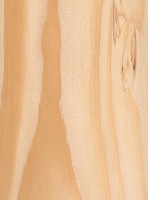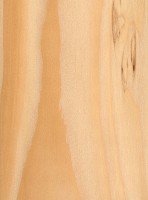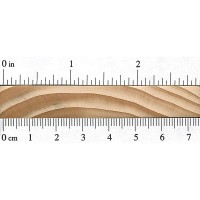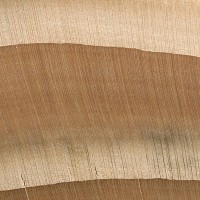 |
Common Name(s): Eastern Hemlock, Canadian Hemlock Scientific Name: Tsuga canadensis Distribution: Eastern North America Tree Size: 65-100 ft (30 m) tall, 2-3 ft (.6-1 m) trunk diameter Average Dried Weight: 28 lbs/ft3 (450 kg/m3) Specific Gravity (Basic, 12% MC): .36, .45 Janka Hardness: 500 lbf (2,220 N) Modulus of Rupture: 8,900 lbf/in2 (61.4 MPa) Elastic Modulus: 1,200,000 lbf/in2 (8.28 GPa) Crushing Strength: 5,410 lbf/in2 (37.3 MPa) Shrinkage: Radial: 3.0%, Tangential: 6.8%, Volumetric: 9.7%, T/R Ratio: 2.3 |
Color/Appearance: Heartwood is light reddish brown. Sapwood may be slightly lighter in color but usually isn’t distinguished from the heartwood. The conspicuous growth rings can exhibit interesting grain patterns on flatsawn surfaces.
Grain/Texture: Grain is generally straight, but may be interlocked or spiraled. Has a coarse, uneven texture.
Endgrain: Resin canals absent; earlywood to latewood transition ranges from moderately abrupt to gradual, color contrast fairly high; tracheid diameter medium-large.
Rot Resistance: Rated as non-durable regarding decay resistance, and also susceptible to insect attack.
Workability: Working properties are intermediate. The wood tends to splinter easily when being worked, and tends to plane poorly. Also, because of the disparity between the soft earlywood and the hard latewood, sanding can create dips and uneven surfaces. Glues, stains, and finishes well.
Odor: No characteristic odor.
Allergies/Toxicity: Eastern Hemlock has been reported to cause skin irritation. See the articles Wood Allergies and Toxicity and Wood Dust Safety for more information.
Pricing/Availability: Eastern Hemlock is one of the two primary commercial species of hemlock harvested in North America—with the other being Western Hemlock (Tsuga heterophylla). Hemlock is used primarily as a construction timber, and is in good supply. Expect prices to be moderate for a domestic softwood.
Sustainability: This wood species is not listed in the CITES Appendices, but is reported by the IUCN as being near threatened. Technically it doesn’t meet the Red List criteria of a vulnerable or endangered species, but is close to qualifying and/or may qualify in the near future.
Common Uses: Boxes, pallets, crates, plywood, framing, and other construction purposes.
Comments: In addition to its lumber, Eastern Hemlock is also known for its ornamental value, and hundreds of cultivars are known to exist. Eastern Hemlock is also the state tree of Pennsylvania. Currently, the species is threatened by the hemlock woolly adelgid, a non-native insect that kills infested trees.
When compared to Western Hemlock (Tsuga heterophylla), Eastern Hemlock generally has wider growth rings, though both species can have tightly spaced growth rings.
None available.








A nice softwood, kind of like a coarser version of white pine. Clear heartwood demarcation from sapwood. Bark hard to distinguish from other species of pine or spruce, with the same reddish inner bark. Not resistant to decay. I’ve found it to be about the same weight and stiffness as white pine. Much slower growing. I’ve seen huge hemlocks go to waste. Never seen it as a lumber species though. Probably because M.O. E. is better in spruce. Beats true a fir any day though. And the tiny cones are fun!
We have property in North Georgia with several blighted Hemlocks. What is the best way to repurpose the wood when building our home? Is it appropriate for intererior use besides framing?
Hemlock R value is 3
It’s more about 1.3 or less according to Bruce Hoadley and this page. (https://books.google.ca/books?id=5HBH2ibu-ZwC&lpg=PP1&pg=PA103#v=onepage&q&f=false)
like this site, easy to read and use. don’t change it.
Should do a article on Weather and bug resistant woods for exterior and inground use
Why do people put wood on the ground? This leads to rot and decay. Stone and concrete are materials used for “groundwork”. Wood should be respected, it is a limited resource. The price of wood is too low, unless it is farmed wood that is harvested too quick. The best wood is old growth, and unfortunately it is nearly impossible to get because our predecessors did not value it high enough.
Hi Cameron. In the US you are mistaken on several accounts. Trees like Black Locust are naturally rot resistant and grow like weeds. Old log cabins (100+ years old) exposed to US weather conditions (well bellow freezing, snowy, icy winters, well above body temepratures hot humid rainy summers, and high harsh winds throughout the year), originally constructed with the stuff are still standing and will likely stay standing for quite a while. Black Locust fence posts will outlast steel and concrete when put into damp ground as well if neither are chemically treated to prevent corrosion and soil fungi and… Read more »
Hi ‘Me Itstrue’, I have heard that black locust was incredibly hard (Janka hardness) as well as rot resistant, but I had my doubts as to how well it performs in the ground. It is not commonly available here in Oregon as an option. We mainly stock soft woods, common domestic hardwood: oak, maple, walnut and cherry. I should note, my comment was primarily in reference to soft woods in response to a comment about hemlock. See also: pine, fir, and western style “cedars”. All of these woods will rot when left out in the elements. If left in the… Read more »
Regardless of it’s rot resistance, it will last exponentially longer if you keep it protected and off the ground
We use black locust fence post on our NY farm. We have found they “only” have a 30 year life. It’s pretty good, but not going to last much longer than that. They still look good, but most of them have become brittle and weak.
Hi Alex, Just interested in the potential of Black Locust. Are your fence posts a commercial product or wood you cut yourself? And about how old are the trees? I’ve found locust to be rather variable in longevity. The best stuff is almost as good as teak. Anyway, 30 years is pretty amazing, right?
We have a couple acres in upstate NY that we harvest ourselves for personal use. Sadly the grove hasn’t been well maintained in the last 10 years it’s getting out of hand. It’s a future project of mine.